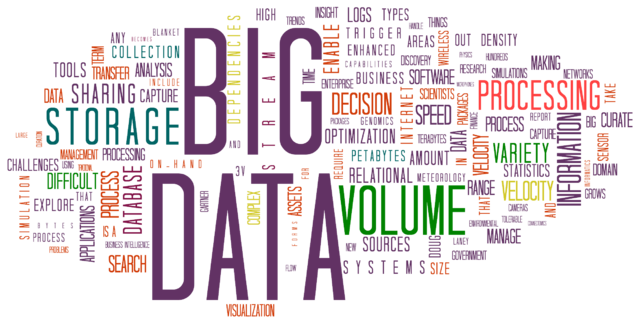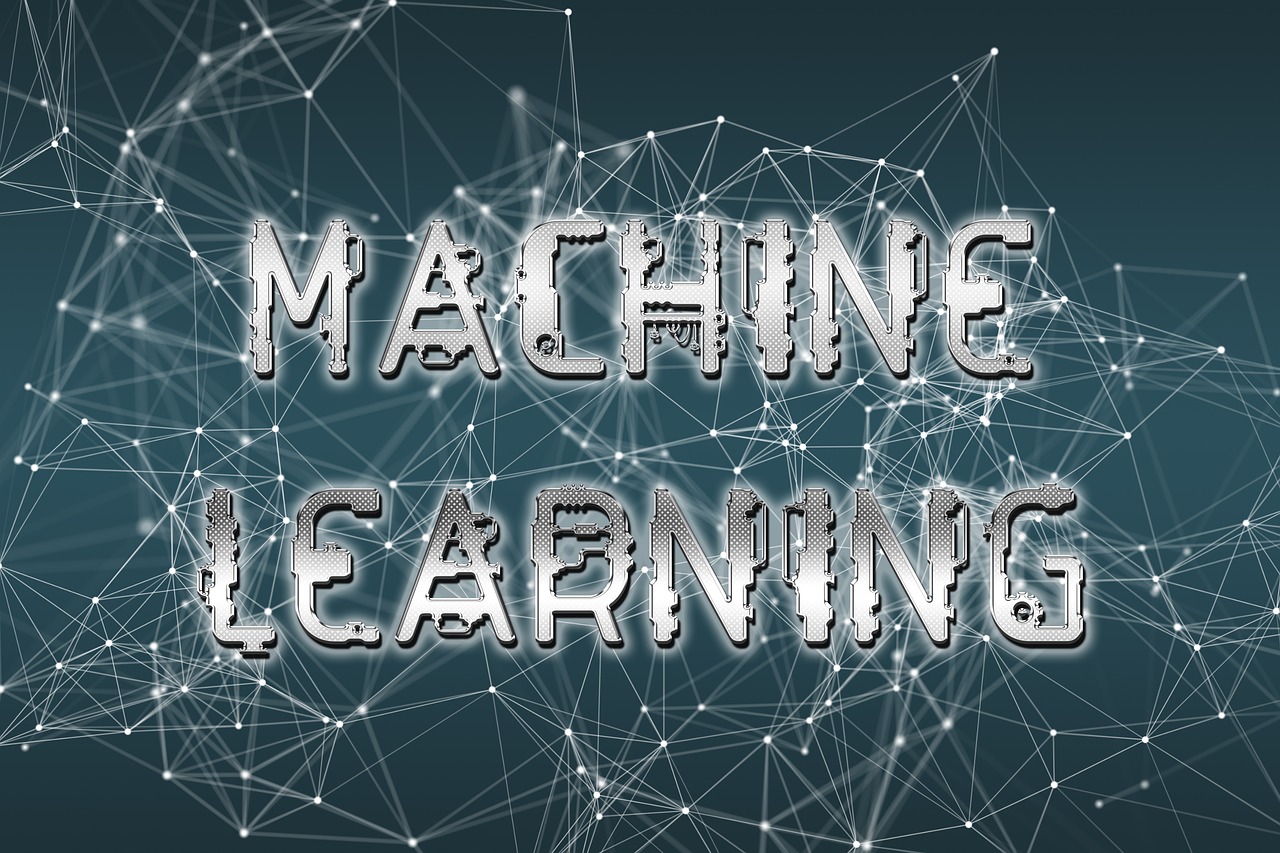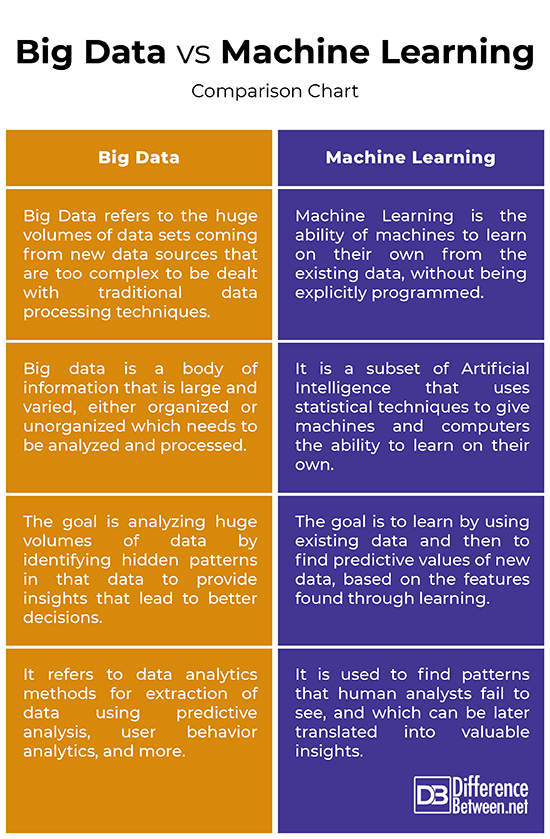Difference Between Big Data and Machine Learning
There have been so many stories and hype surrounding the terms Big Data and Machine Learning, and how they can transform your businesses. These are often portrayed as the ultimate solution to all those things that cause problems for organizations. No wonder these are the most talked-about buzzwords these days, but people hardly understand the nuances of each concept. Both the terms are quite popular among new-age technologies and everything from social network to the online shopping is directly linked with big data and machine learning. Big Data is related to High-Performance Computing whereas machine learning is a part of Data Science. Let us look at the two individually.

What is Big Data?
Big data is the term used to describe the extremely large volumes of data sets coming from new data sources that are too voluminous and complex to be dealt with conventional data processing techniques. In some technical situations, Big data means petabytes scale, unstructured chunks of data mined or generated from the Internet. Big data is a body of information that is large and varied, and with the right tools, big data can be extremely valuable. The term ‘big data’ appears to have been first used in the late 1990s and the first academic paper was published in 2003, by Francis X. Diebolt – “Big Data Dynamic Factor Models for Macroeconomic Factor Measurement and Forecasting” – but the credit mostly goes to John Mashey, the first person to use the term “big data”. Some key technologies and influential events have paved way for the big data era.

What is Machine Learning?
If Big Data describes the huge amounts of data and information at our disposal, machine learning describes the way to analyze that data. Machine Learning is a subset of Artificial Intelligence (AI) that uses statistical techniques to give machines and computers the ability to learn on their own, without being explicitly programmed. Machine learning means the ability of machines to learn on their own. Humans program the computers to learn without telling them what to do. Machines learn by looking at the data. The idea is to learn by using existing data and then to find predictive values of new data, based on features that were found through learning. Machine learning refers to algorithms that learn on their own, based on probability and data, to infer results. It can be said that, it is a process by which software applications learn to increase their accuracy in order to predict outcomes.
Difference between Big Data and Machine Learning
Terminology
– Big Data is a term used to describe the huge volumes of data sets coming from new data sources that are too voluminous and complex to be dealt with traditional data processing techniques. Big data refers to the data being generated every day at break-neck pace, and which needs to be processed, stored, and analyzed for future insights.
Machine Learning, on the other hand, is the ability of machines to learn on their own from the existing data, without being explicitly programmed.
Concept
– Big data is a body of information that is large and varied, and with the right tools, big data can be extremely valuable. Big data refers to the large, diverse sets of data collected from a variety of sources, including social media, Internet of Things, sensory devices, Cloud storage, websites and more. The data is then collected and analyzed for hidden patterns and other useful information.
Machine Learning is used to find patterns that human analysts fail to see, and which can be later translated into valuable insights.
Purpose
– Big Data involves storage, ingestion, and data extraction tools such as Hadoop. The purpose of Big Data is to analyze huge volumes of data by identifying hidden patterns or extracting information from that data to provide insights that lead to better decisions and pursue new business models or to gain a significant competitive advantage.
The purpose of machine learning is to learn by using existing data and then to find predictive values of new data, based on the features found through learning.
Applications
– Big data has numerous strategic business applications across almost every industry vertical, including healthcare, retail, insurance, transportation, e-commerce, and telecommunications. Big data can be used to optimize processes and asset utilization in real-time, enrich quality of customer solutions, provide better insights, accelerate innovation process, etc.
Real world applications of machine learning include virtual assistants, smart devices, traffic predictions and weather reporting, video surveillance, facial recognition, malware filtering, computer visions, and more.
Big Data vs. Machine Learning: Comparison Chart

Summary of Big Data vs. Machine Learning
In a nutshell, Big Data is related to High-Performance Computing whereas machine learning is a part of Data Science. The idea is getting the right data and using computers to identify patterns that humans failed to see or could not find previously. Big data is the process of storing, manipulating, and analyzing the data coming from a variety of sources in new and efficient ways. If Big Data describes the huge amounts of data and information at our disposal, machine learning describes the way to analyze that data. Machine Learning is the ability of machines or computers to learn from existing data and find patterns in that data that humans failed to find.
- Difference Between Caucus and Primary - June 18, 2024
- Difference Between PPO and POS - May 30, 2024
- Difference Between RFID and NFC - May 28, 2024
Search DifferenceBetween.net :
Leave a Response
References :
[0]Dean, Jared. Big Data, Data Mining, and Machine Learning: Value Creation for Business Leaders and Practitioners. Hoboken, New Jersey: John Wiley & Sons, 2014. Print
[1]Song, Juyoung and Tae Min Song. Big Data Analysis Using Machine Learning for Social Scientists and Criminologists. Newcastle, England: Cambridge Scholars Publishing, 2019. Print
[2]Hung, Patrick C.K. Big Data Applications and Use Cases. Berlin, Germany: Springer, 2016. Print
[3]Srinivasan, S. Guide to Big Data Applications. Berlin, Germany: Springer, 2016. Print
[4]Image credit: https://upload.wikimedia.org/wikipedia/commons/thumb/e/e3/BigData_2267x1146_trasparent.png/640px-BigData_2267x1146_trasparent.png
[5]Image credit: https://cdn.pixabay.com/photo/2019/04/15/12/09/machine-learning-4129175_1280.jpg
